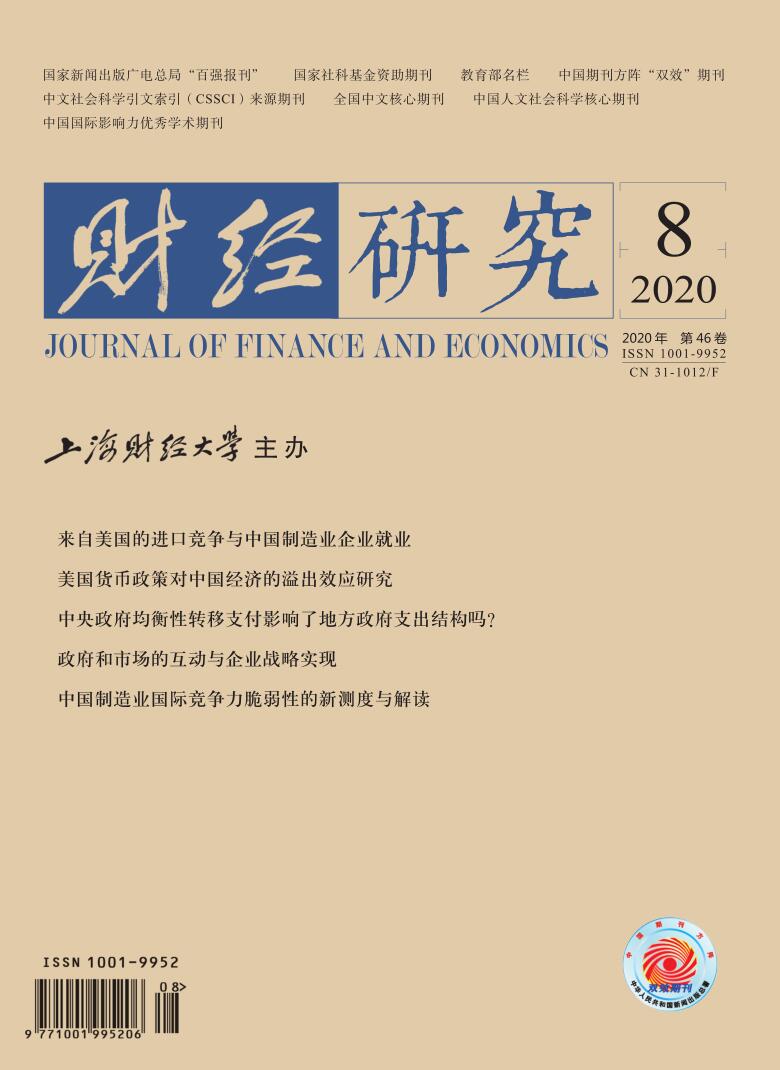近年来,越来越多的非金融企业将大量的资金投资于金融资产,使得我国经济出现了明显的“脱实向虚”趋势。文章基于同群效应的视角,考察了我国企业金融化行为传染效应的存在性、发生机制及其经济后果。利用2007−2016年间沪深A股上市公司的数据,文章研究发现,企业的金融化决策存在显著的传染效应,企业的金融化程度与同行业或同省份其他企业的平均金融化程度显著正相关,该结论在控制内生性问题后仍然成立。“信息学习”动机和“代理成本”是驱动企业金融化同群效应的潜在原因,主要表现为具有信息劣势的追随企业倾向于模仿具有信息优势的领导企业的金融化行为,但反之不成立;并且,外部信息环境越差、不确定性程度越高、代理成本越高,企业金融化的同群效应越强。进一步研究发现,基于同群效应的金融化降低了企业的特质风险,但增加了企业面临的系统性风险和总体风险。文章的研究为理解我国经济“脱实向虚”的发生机制及经济后果提供了一个新的微观视角。
企业“脱实向虚”如何传染?——基于同群效应的视角
摘要
参考文献
8 刘伟,曹瑜强. 机构投资者驱动实体经济“脱实向虚”了吗[J]. 财贸经济,2018,(12):80−94. DOI:10.3969/j.issn.1002-8102.2018.12.007
14 王红建,曹瑜强,杨庆,等. 实体企业金融化促进还是抑制了企业创新−基于中国制造业上市公司的经验研究[J]. 南开管理评论,2017,(1):155−166. DOI:10.3969/j.issn.1008-3448.2017.01.014
20 Adhikari B K,Agrawal A. Peer influence on payout policies[J]. Journal of Corporate Finance,2018,48: 615−637. DOI:10.1016/j.jcorpfin.2017.12.010
21 Baker S R,Bloom N,Davis S J. Measuring economic policy uncertainty[J]. The Quarterly Journal of Economics,2016,131(4): 1593−1636. DOI:10.1093/qje/qjw024
22 Bird A,Edwards A,Ruchti T G. Taxes and peer effects[J]. The Accounting Review,2018,93(5): 97−117. DOI:10.2308/accr-52004
23 Bustamante M C, Frésard L. Does firm investment respond to peers’ investment? [R]. Robert H. Smith School Research Paper No. RHS 2827803, 2017.
24 Cai H B,Fang H M,Xu L C. Eat,drink,firms,government:An investigation of corruption from the entertainment and travel costs of Chinese firms[J]. The Journal of Law and Economics,2011,54(1): 55−78. DOI:10.1086/651201
25 Demir F. Financial liberalization,private investment and portfolio choice:Financialization of real sectors in emerging markets[J]. Journal of Development Economics,2009,88(2): 314−324. DOI:10.1016/j.jdeveco.2008.04.002
26 Dougal C,Parsons C A,Titman S. Urban vibrancy and corporate growth[J]. The Journal of Finance,2015,70(1): 163−210. DOI:10.1111/jofi.12215
27 Duong H K,Ngo A D,McGowan C B. Industry peer effect and the maturity structure of corporate debt[J]. Managerial Finance,2015,41(7): 714−733. DOI:10.1108/MF-02-2014-0050
28 Firth M,Fung P M Y,Rui O M. Corporate performance and CEO compensation in China[J]. Journal of Corporate Finance,2006,12(4): 693−714. DOI:10.1016/j.jcorpfin.2005.03.002
29 Graham J R. Herding among investment newsletters:Theory and evidence[J]. The Journal of Finance,1999,54(1): 237−268. DOI:10.1111/0022-1082.00103
30 Graham J R,Harvey C R. The theory and practice of corporate finance:Evidence from the field[J]. Journal of Financial Economics,2001,60(2−3): 187−243. DOI:10.1016/S0304-405X(01)00044-7
31 Grennan J. Dividend payments as a response to peer influence[J]. Journal of Financial Economics,2019,131(3): 549−570. DOI:10.1016/j.jfineco.2018.01.012
32 Gul F A,Kim J B,Qiu A A. Ownership concentration,foreign shareholding,audit quality,and stock price synchronicity:Evidence from China[J]. Journal of Financial Economics,2010,95(3): 425−442. DOI:10.1016/j.jfineco.2009.11.005
33 Leary M T,Roberts M R. Do peer firms affect corporate financial policy?[J]. The Journal of Finance,2014,69(1): 139−178. DOI:10.1111/jofi.12094
34 Lieberman M B,Asaba S. Why do firms imitate each other?[J]. Academy of Management Review,2006,31(2): 366−385. DOI:10.5465/amr.2006.20208686
35 Morck R,Yeung B,Yu W. The information content of stock markets:Why do emerging markets have synchronous stock price movements?[J]. Journal of Financial Economics,2000,58(1-2): 215−260. DOI:10.1016/S0304-405X(00)00071-4
37 Shin H S, Zhao L Y. Firms as surrogate intermediaries: Evidence from emerging economies[R]. Asian Development Bank Working Paper, 2013.
38 Smallwood D E,Conlisk J. Product quality in markets where consumers are imperfectly informed[J]. The Quarterly Journal of Economics,1979,93(1): 1−23. DOI:10.2307/1882595
39 Stock J H, Yogo M. Asymptotic distributions of instrumental variables statistics with many instruments[A]. Andrews D W K, Stock J H. Identification and inference for econometric models[M]. Cambridge: Cambridge University Press, 2005.
40 Stulz R M. Rethinking risk management[J]. Journal of Applied Corporate Finance,1996,9(3): 8−25. DOI:10.1111/j.1745-6622.1996.tb00295.x
41 Tori D, Onaran O. The effects of financialisation and financial development on investment: Evidence from firm-level data in Europe[R]. Working Paper, 2017.
引用本文
李秋梅, 梁权熙. 企业“脱实向虚”如何传染?——基于同群效应的视角[J]. 财经研究, 2020, 46(8): 140-155.
导出参考文献,格式为:






 6177
6177  8840
8840

